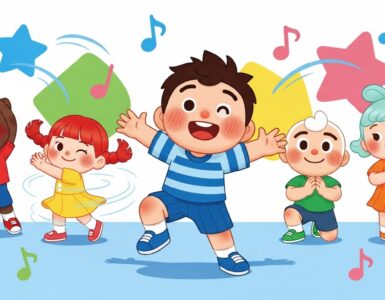Baa Baa Black Sheep Animal Songs for Kids is a charming nursery rhyme that captures the imagination of young children. Its catchy melody and enchanting lyrics are not only entertaining but also serve as an educational tool, promoting early language development and cultural literacy. This beloved song, along with others like it, creates a gateway into the world of animals, sounds, and rhythm—making it a vital part of childhood entertainment.
The Importance of Animal Songs in Early Childhood Development
Animal songs play a significant role in the early stages of a child’s life. They provide an engaging avenue for learning about animals, their sounds, and their behaviors. Additionally, these melodies foster cognitive, social, and emotional growth in children.
Fostering Cognitive Skills Through Songs
When children sing animal songs, they begin to understand patterns, rhythms, and sequences. The repetitive nature of the lyrics helps solidify memory retention. For example, “Baa Baa Black Sheep” has a simple structure that makes it easy for kids to remember and even sing along.
This kind of repetition is crucial for developing linguistic skills. As children learn new words and phrases, they start to associate them with meanings and sounds, enhancing their vocabulary. The process of connecting a sound to a word is foundational in language acquisition, making animal songs an essential resource for parents and educators alike.
Moreover, music can stimulate brain functions. Studies have shown that exposure to nursery rhymes and songs during early development can ignite interest in reading and writing later on. The rhythm and rhyme of animal songs help children predict what comes next, fostering critical thinking and problem-solving skills. Thus, singing songs like “Baa Baa Black Sheep” is not merely a recreational activity; it’s a powerful tool for cognitive growth.
More: Preschool Learning at CoComelon School! CoComelon
Social Interaction and Emotional Connections
Singing animal songs often brings children together, whether in a classroom setting or at home. These shared experiences create bonds among peers, allowing them to express themselves freely in a safe environment. The act of singing fosters a sense of community and belonging, which is pivotal in social skill development.
Furthermore, children often mimic the sounds of animals while singing, generating laughter and joy. This interaction can be incredibly therapeutic, helping children to express their emotions and develop empathy. An animal song serves as a medium through which children can explore feelings, from excitement to sadness, by connecting with the characteristics of the animals being sung about.
Enhancing Cultural Literacy and Awareness
Animal songs are not confined to a single culture; they transcend borders and languages. “Baa Baa Black Sheep,” for instance, has various adaptations worldwide, each reflecting local customs and folklore. Introducing children to such songs fosters an awareness and appreciation for cultural diversity.
By learning these melodies, children not only acquire language skills but also gain insight into different cultures and lifestyles. Understanding the origins and variations of animal songs can lead to rich discussions about the world around them, broadening their perspectives and nurturing curiosity. Such awareness is indispensable in today’s increasingly globalized society.
Engaging Children with Animal Sounds and Actions
Incorporating actions and sounds into animal songs enhances engagement and makes the learning experience memorable. When children physically interact with the song, they create a multisensory experience that deepens understanding.
Creating Interactive Experiences with Animal Songs
To make “Baa Baa Black Sheep” more interactive, caregivers can encourage children to mimic the sheep’s baaing along with the song. This playful imitation not only makes the activity fun but also reinforces auditory learning. In addition to vocal imitations, movements can be introduced, such as pretending to shear the sheep or gently bouncing to the rhythm of the song.
Using props can further elevate this experience. Simple items like stuffed animals or puppets can make the song come alive. Children can hold a plush sheep while singing, creating a tangible connection to the lyrics. This type of interaction also harnesses fine motor skills as little hands grasp, move, and manipulate the objects.
Utilizing Technology for Enhanced Interaction
In our modern age, technology offers numerous avenues to engage children with animal songs. Educational apps and websites often feature animated versions of classic nursery rhymes. These digital platforms can visually represent the animals and their sounds, offering a dynamic way for children to connect with the content.
Many of these platforms allow children to participate actively, enabling them to touch screens to make animals appear or produce sounds. Additional features might include games or quizzes related to the song, reinforcing learned concepts. Technology thus becomes an invaluable ally in bringing traditional songs like “Baa Baa Black Sheep” into contemporary contexts.
Collaborating with Other Subjects
Animal songs can also be integrated into other areas of learning, such as science, art, and geography. For instance, discussing the behavior of sheep and their habitats can follow the song’s narrative. This integration allows for holistic learning, where children draw connections between different subjects.
Art projects like drawing sheep or crafting farm scenes can accompany the song, encouraging creative expression. Meanwhile, geography lessons can introduce children to regions famous for sheep farming. Such interdisciplinary approaches not only enhance the educational value of animal songs but also offer richer learning experiences.
The Evolution of “Baa Baa Black Sheep” and Its Variations
The journey of “Baa Baa Black Sheep” is fascinating, showcasing how songs evolve over time and across cultures. Exploring its history and variations can reveal much about societal changes and cultural context.
Historical Roots of “Baa Baa Black Sheep”
“Baa Baa Black Sheep” dates back to the 18th century and has been attributed to various authors. Some insights suggest that the song may stem from the wool trade, which was a significant industry in England, particularly in the West Country. The lyrics reflect economic realities of the time, blending educational elements with socio-political commentary.
Understanding the historical backdrop of the song adds depth to its meaning. Children can learn about the lives of farmers, the significance of sheep in agriculture, and the concept of trade. This kind of contextual learning transforms a simple nursery rhyme into a springboard for broader discussions about history and society.
Global Adaptations and Variations
Around the globe, “Baa Baa Black Sheep” has inspired numerous adaptations. In some cultures, variations exist that feature different animals or entirely new lyrics. For example, in Spain, the equivalent rhyme introduces goats instead of sheep, emphasizing local livestock.
Exploring these variations can provide exciting opportunities for children to appreciate different languages and cultural expressions. Educators can lead discussions comparing versions, inviting children to think critically about why certain animals are featured in specific cultures. This promotes cultural sensitivity and curiosity, enticing young minds to explore beyond their immediate surroundings.
Modern Interpretations and Remixes
In recent years, “Baa Baa Black Sheep” has found itself in contemporary media, often remixed or reimagined in various formats. From television shows to children’s music albums, the song continues to capture hearts in innovative ways.
These modern interpretations often introduce new characters or settings, revitalizing the original tale for today’s audience. By presenting the song in fresh contexts, such as animated videos or catchy pop renditions, creators ensure its relevance in a rapidly changing world. This continuous evolution keeps the song accessible and appealing to new generations while honoring its roots.
Teaching Life Lessons Through Animal Songs
Animal songs like “Baa Baa Black Sheep” go beyond mere entertainment; they carry valuable life lessons that resonate with young audiences. Through storytelling and melodic narratives, children are introduced to concepts of sharing, kindness, and compassion.
Lessons on Sharing and Generosity
At its core, “Baa Baa Black Sheep” tells a story of giving. The sheep generously provides wool for a variety of people, signifying the importance of sharing resources and supporting one another. This theme can spark conversations about generosity in children’s lives, encouraging them to think about how they can share toys, food, and kindness with friends and family.
Parents and educators can facilitate discussions around the idea of giving and receiving. Questions like, “What do you like to share with your friends?” or “How does it feel to give something special to someone else?” help children develop emotional intelligence. By exploring these themes within the framework of a familiar song, they learn valuable lessons about empathy and community.
Building Compassion for Animals
Animal songs often serve as gateways for children to develop compassion towards animals. Singing “Baa Baa Black Sheep” can prompt discussions about the care and responsibility associated with raising animals. Children can learn about where wool comes from, the needs of sheep, and the importance of treating all living beings with respect.
Encouraging children to empathize with animals prepares them to form responsible attitudes toward pets and wildlife. Activities like visiting farms or volunteering at shelters can further reinforce these principles, fostering a generation that values and protects the natural world.
Inspiring Creativity and Imagination
Animal songs also inspire creativity and imaginative play. Through the lens of “Baa Baa Black Sheep,” children can envision a world filled with anthropomorphic animals engaging in various activities. This imaginative exploration nurtures their ability to create stories, play pretend, and express themselves artistically.
Caregivers can enhance this aspect by introducing imaginative play scenarios based on the song. For instance, having children act out roles as shepherds or fluffy sheep encourages cooperative play and storytelling. These activities cultivate confidence in self-expression, allowing children to explore identities and narratives in a safe setting.
Conclusion
Baa Baa Black Sheep Animal Songs for Kids serve as a delightful blend of education and entertainment. Through engaging melodies and relatable themes, these songs promote cognitive, social, and emotional development in young children. They invite exploration of the world around them, helping children forge connections with animals, culture, and each other.
As we continue to incorporate these timeless tunes into our teaching and parenting practices, let us remember their profound impact on shaping young minds. Whether through interactive experiences, interdisciplinary learning, or life lessons, animal songs remain a treasured component of childhood—a sweet harmony resonating through generations.















